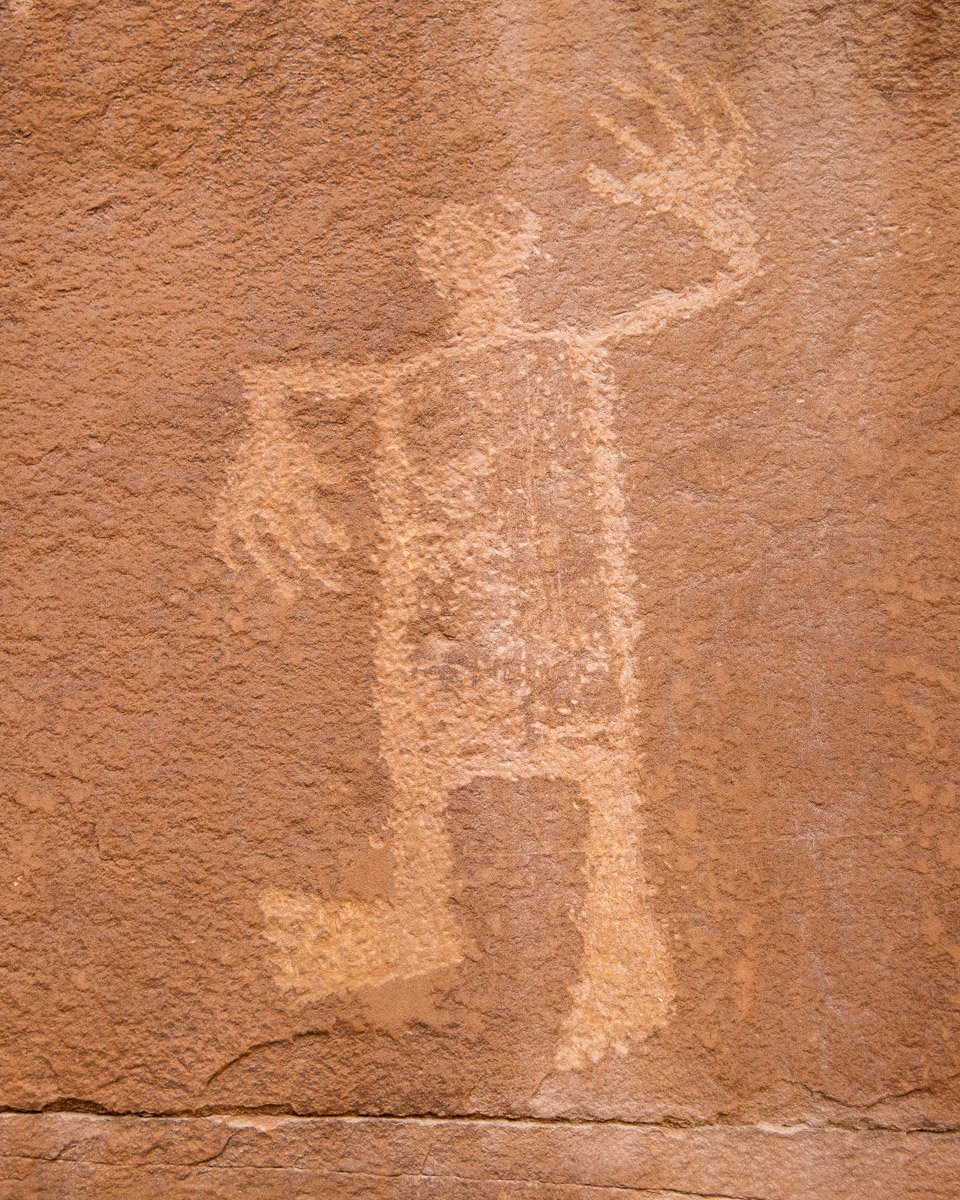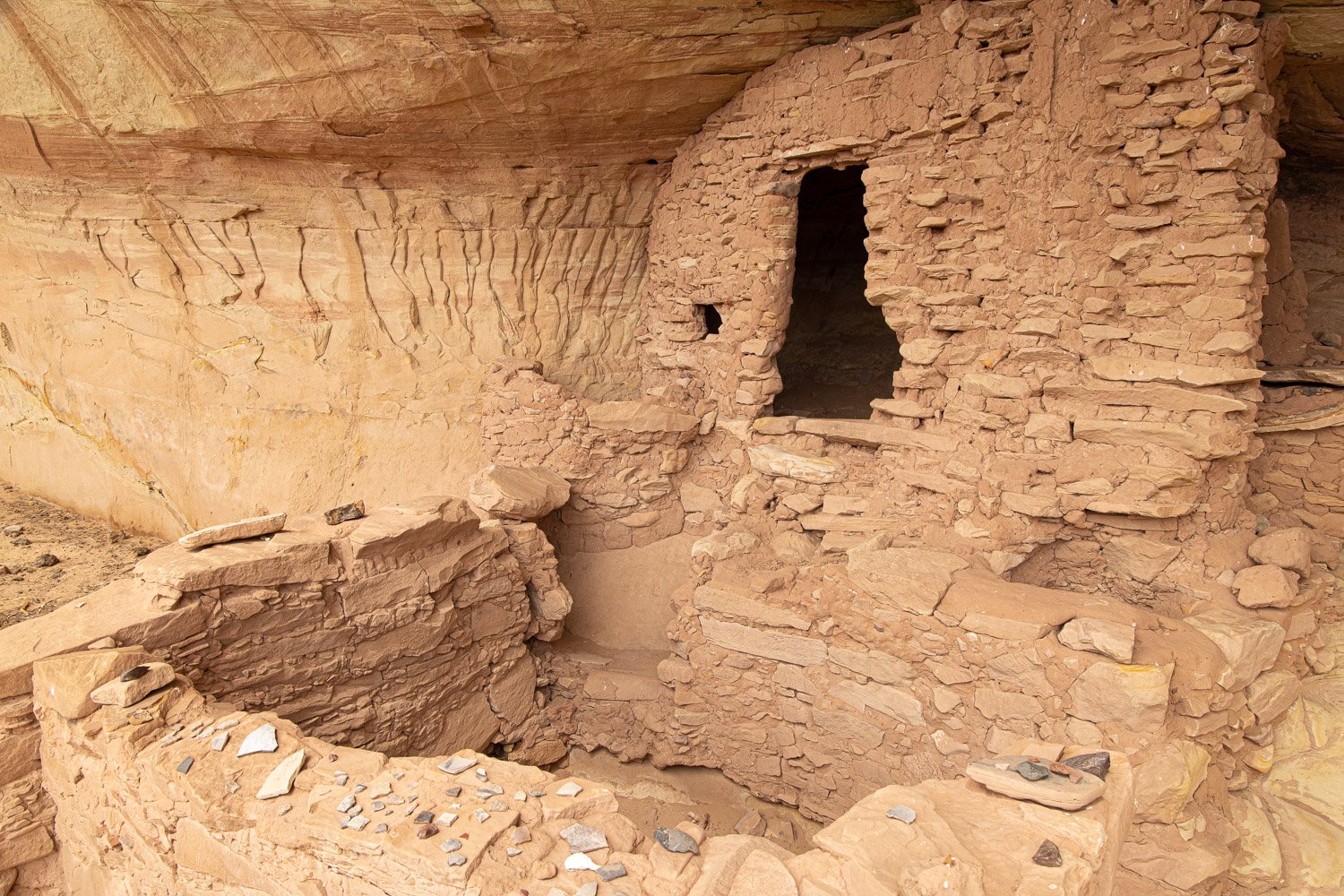A couple of the images in last week’s post were of Cold Spring Cave on Comb Ridge. That hike was followed by what was the most profound hike of the trip into Monarch Cave. I’ll write about that later. I thought of doing another hike that day to a site called Wolfman Panel, but it was getting late and we were tired from hiking and decided to head west to our next location and look for a camping spot. When we returned east a day later, I wanted to drive back up Comb Ridge and try for Wolfman Panel again. We hiked through Butler Wash and got to slickrock with Comb Ridge in the background, and thought it’d make a good picture with Chance.
Comb Ridge, Bears Ears National Monument, Utah
We were approaching the canyon that we’d be walking along and where we should find the Wolfman Panel on our east side of the canyon. However, as I’m looking at Chance and down into the canyon I see that some structures were built over there and that we might need to lengthen our hike and explore the west side of the canyon. But first, we worked our way down into our east side of the canyon and soon met the Wolfman.
Before this trip, I’d read House of Rain by Craig Childs. His very engaging writing is essentially a collection of essays of his travels and experiences around the Four Corners area and beyond. In that book he explores the peripatetic history of the Ancestral Puebloans, and one chapter was based on a hike on Comb Ridge that inspired me to visit this area. He just published a new book, Tracing Time: Seasons of Rock Art on the Colorado Plateau. I’m about half way through, and once again thoroughly engrossed by his writing.
“When I take a picture of a rock art panel, I’m both frustrated that I can’t include everything and glad I can’t, because where would it end?
“I have the same challenge with the journal in my hand as I enter words about the hummingbird and the bodies around it, trying to take in the waning afternoon and the broad shotgun of this valley. Writing may be able to encompass a larger spectrum than photography, but it is still a frame. Most of the pieces are left out. I see only the basic picture, something ancient on a wall, perhaps sleepers, dreamers, portrayals of the dead from a people I scarcely know. This is the nature of a colonist, a person in unfamiliar land. No matter how many marriages and births occurred in my family line, I’ve barely arrived. I am stepping foot on my own home ground in a land that is not mine. I plant the flag of my body at a row of ghostmen where later, after sunset, I’ll take my flag back down and go home.”
Craig Childs, Tracing Time pp 34-35.
The two foot high Wolfman was a low key greeter to the spectacular petroglyphs that were soon high on the wall pecked into the darker desert patina. Unbelievably, (or perhaps not) some idiot had desecrated the images with rifle blasts into the wall. Continuing along the canyon wall, there was a glimpse of the old buildings ahead and the most spectacular parts of this panel.
Bears Ears National Monument contains over 100,000 cultural sites. This panel is likely from the later Basketmaker period before 750 CE. One of the experts Childs interviews is Laurie Webster, and she mentions the fellow in this panel when talking about woven waist sashes found in some burials nearby.
“Webster sees the same sash on the tall petroglyph of a man near the San Juan River in Utah, a site called the Wolfman Panel. A male is rendered in sharp detail down to the curve of calf and thigh muscles, his hands and feet enlarged and hanging down as if floating, which may depict someone who has died, or who has spiritual powers. He wears a head ornament, a hair comb with what is believed to be a feathered top. A remnant of dark zigzag paint shows at his waist, what Webster takes to be the same kind of woven sash she saw on the young man buried in the cave.
“‘I’m wondering if that’s all men wore, if they wore braided sashes around their waist and let it all hang out,’ she said.”
Craig Childs, Tracing Time p 82.
What captures my attention are the two sandhill cranes next to the man. These images may have been made over 1,300 years ago, but a million years before even the Basketmaker people were here, the cranes were migrating through. Why did people add these birds to this panel? Five months earlier in November, I saw thousands of Sandhills a few hundred miles south of here along the Rio Grande in New Mexico. They spend the winter there and further south and would fly through this area in November on the way south and again in March heading north from the Rio Grande to the San Juan to the Platte River and some on to Canada and Alaska. They would only be here briefly passing through. This wall faces west. Does the light hit here around the spring equinox when they are flying north? At my home on the eastern flyway, I paint them in my head on St. Patrick’s Day when I hear and see them going north. Why did these people put these brief visitors here next to these other figures?
The mystery of those buildings on the other side of the canyon was too great, so Chance and I worked our way down to the wash and through the reeds growing there. Chance drank some water, reminding us why they built their homes here, and we headed up the canyon wall on the west side. Though you are not suppose to take or even move and relics you find, people place potsherds they find on rocks or walls like the collection seen here. Many are plain, some are inscribed or patterned in shapes and colors.
There were more petroglyphs and many pictographs on this side of the canyon, too. There were several very graphic stars incised into the walls. Then there was this petroglyph of a much more recent origin. Is this some recent graffiti or is it from some 19th century visitors? And note—they wear sashes.
I’m a recent visitor to this canyon that has had many people living and visiting here for thousands of years. And all of us are recent visitors to the generations of animals and birds who have traveled through and around Comb Ridge.
“How long till my lines become indigenous is hardly worth talking about, not something that ever happens. I’m thinking many thousands of years, but that might be a stretch. Coming to this panel might be a way of asking permission, standing with a shield figure at sunrise, bearing the same cold, the same expectation for sunrise.”
Craig Childs, Tracing Time, p 65.






